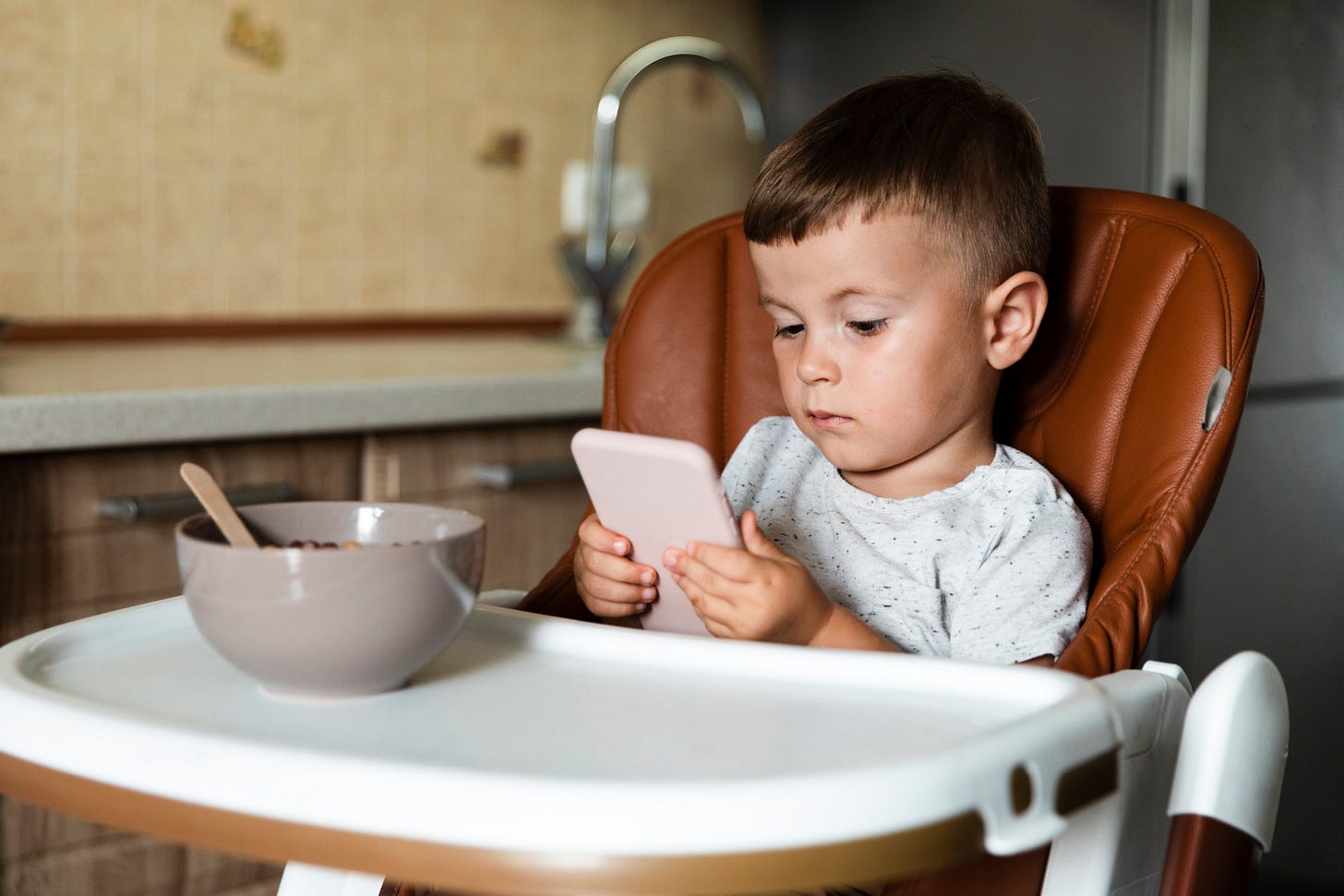[Blog] Ep 56. Harsh Consequences of Excessive Screentime on Brain Development
ft Dr Madhumitha Ezhil
Introduction
Screens are everywhere, from high chairs to bedtime routines, and for many modern parents, managing screen time has become one of the most frustrating and confusing parts of raising young children. In this episode of The Modern Indian Parent Podcast, host Rinni Gupta sits down with Dr. Madhumita Ezal, a screen-time reduction expert and PhD in consumer psychology, to unpack the science, the risks, and the real-life impact of excessive screen exposure in kids. Known widely on Instagram as @screenfreeparent, Dr. Madhu shares insights from her research, the darker side of “educational” content, the rise of virtual autism, and how families can regain balance without turning parenting into a battleground. Whether you’re dealing with tantrums, navigating grandparents, or simply wondering how much screen time is too much—this episode offers the clarity and compassion you’ve been looking for.
56.Harsh Consequences of Excessive Screentime on Brain Development ft. Dr Madhumitha Ezhil
What exactly happens inside a child’s brain when they spend hours glued to screens?
Dr. Madhumita’s Journey into Screen Time Reduction
Dr. Madhumita began her career helping brands increase screen time. Her PhD focused on getting adults to scroll and shop more online. But after reading about the manipulative tactics used in children’s content, she shifted gears entirely—choosing instead to help families reduce digital exposure.
Her journey in a nutshell:
PhD focus: maximizing adult time online for e-commerce.
Realization: similar manipulative research being used to hook children.
Trigger: a New York Times article about Cocomelon’s frame-by-frame edits to hold attention.
Response: began breaking down research into simple reels for parents.
Outcome: viral content, growing demand, and the launch of her full-time screen-free parenting course.
Recommended Screen Time for Babies and Toddlers
Dr. Madhumita clearly outlines the internationally agreed screen time guidelines for young children. She emphasizes that quality matters more than quantity, and warns against over-focusing on “just one hour” without considering what is being shown.
Guidelines shared:
Under 2 years: No screen time, except for video calls.
18–24 months: Begin with small doses (~30 mins) of high-quality content.
2 to 5 years: Max 1 hour per day of high-quality programming.
Post age 5: No strict time limit, but prioritize sleep, outdoor play, meals, and family time.
What Excessive Screen Time Does to a Child’s Brain
What happens when a child is given unlimited access to YouTube shorts or fast-paced content? Their developing brain is overwhelmed by stimulation and real life begins to feel dull in comparison.
Dr.Madhumita explains:
Shows like Cocomelon use rapid cuts and sound effects to keep kids hooked.
Real-life activities pale in comparison to overstimulating content.
Excessive screen time creates a dopamine surge followed by a crash.
Children’s tantrums post-screen are neurological, not behavioral.
The brain begins to crave more stimulation, not out of defiance but addiction.
Dopamine, Addiction, and the Science Behind Screen Cravings
Dr. Madhumita explains the neurological mechanics behind why screens are so addictive. Like sugar or drugs, screen content gives the brain a powerful dopamine hit, especially in young children.
Dopamine facts from the episode:
Dopamine is a neurotransmitter that pushes us to seek pleasure and reward.
Historically tied to survival (e.g., food, rest), now hijacked by screens.
Kids can’t rationalize or self-regulate the way adults can.
Tantrums after removing screens are like withdrawal symptoms—not manipulation.
Are Educational Shows Like Miss Rachel Actually Beneficial?
While many parents credit shows like Miss Rachel for teaching their kids language or numbers, Dr. Madhumita cautions against over-reliance. Learning only happens when an adult is actively involved.
Important distinctions:
Children under 3 have a “video deficit”—they don’t learn as well from recorded content.
Video calls are the only recommended screen activity under age 2, due to real-time interaction.
Learning improves when parents co-watch and participate.
Shows can teach parents how to talk to their kids, but the parent must be the one engaging.
Understanding Virtual Autism and Its Impact
“Virtual autism” refers to autism-like symptoms in kids exposed to high levels of screen time before age 3. Though not a formal diagnosis, Dr. Madhumita shares how these symptoms can often be reversed when screens are removed.
Key insights:
Caused by >3 hours/day of screen time in toddlers.
Common symptoms: speech delay, poor eye contact, no name response.
Real autism is neurological and not caused by screens.
Virtual autism is reversible; real autism is not.
Recovery is possible in 2 months to 1 year with screen detox.
Early Warning Signs of Screen Overuse in Kids
One of the most surprising patterns Dr. Madhumita Ezal sees in her work is that many cases of excessive screen use and virtual autism come from joint family homes. It seems counterintuitive—wouldn’t having grandparents around mean more active engagement and less screen dependency? But the reality is quite the opposite. Many older caregivers, now in their 60s, 70s, or 80s, simply don’t have the physical energy or capacity to match the needs of an active toddler. With their own health limitations and screen habits (think endless WhatsApp forwards and YouTube shorts), it becomes easier to hand the child a device than chase after them all day.
In many cases, both parents are working, and the child is left in the care of elders who, out of love and convenience, turn to screens as babysitters. On the surface, the child seems well-fed, rested, and safe but internally, neurological development may be silently disrupted. Indian family dynamics also play a role: it’s often considered disrespectful to question elders or interfere in how they choose to care for the child. This silence, unfortunately, contributes to a cycle of unintentional harm.
Early red flags to watch out for include:
No eye contact.
Delayed speech or reduced babbling.
Child constantly asking for screens.
Loss of interest in play or people.
Screen use to eat, sleep, or stay calm.
How to Talk to Grandparents About Reducing Screen Time
In many cases, screen overuse begins in joint families where grandparents use devices to manage active toddlers. Dr. Madhumita shares how to communicate with elders without starting a family conflict.
Her suggestions:
Be willing to be labeled the “fussy” or “overprotective” parent.
Involve a doctor—grandparents often listen more to professionals.
Help elders with low-effort activities: sensory bins, frozen toys, indoor gardening.
Consider daycares or hiring a caregiver for active toddlers.
Include kids in grandparents’ routines (yoga class, cooking, etc.).
When Parents Struggle to Say No to Screens
Parents often cave into tantrums because screen removal triggers extreme emotional responses. Dr. Madhumita shares what to expect and how to respond.
Her approach:
Expect tantrums—they’re normal and temporary.
Hold your boundary; do not give in during meltdowns.
The first 3–7 days are the hardest; then it gets easier.
Don’t distract from emotion—ride the wave with your child.
Offer support, not lectures. Use calming strategies after the tantrum peaks.
Managing Your Own Screen Habits as an Adult
Children imitate adult behavior. Dr. Madhu stresses that reducing your screen time is critical if you want to reduce theirs.
Her personal tactics:
Use greyscale mode on your phone as it makes scrolling less appealing.
Narrate your phone usage aloud to stay accountable in front of your child.
Use rubber bands or tape as a physical barrier on your screen.
Set phone-free zones (bedroom, dining table) and phone-free times (before bedtime).
Make your phone less “easy to use” to break the habit loop.
Is It Safe to Share Your Child’s Images on Social Media?
Dr. Madhu’s stance on “sharenting” is clear: kids cannot consent, and posting their photos can have long-term consequences. From online predators to identity theft, the risks are real.
Her reasons:
Children’s tantrums or private moments should not be broadcast.
Influencers often benefit financially, but children bear the exposure.
Predatory comments have been found on videos of infants as young as 6 months.
AI can now predict what a child will look like in 10–20 years.
Sharing birthdates, school names, or routines compromises safety.
Final Thoughts and How to Reach Dr. Madhumita
As the conversation draws to a close, Dr. Madhumita leaves parents with both hope and a strong call to action: it’s never too late to make a change. Whether you’re struggling with tantrums, dealing with grandparents, or trying to reset your own digital habits, taking the first step toward mindful screen use can make a profound difference. Her courses and content offer practical, research-backed strategies for parents of children aged 0–7. If you'd like to learn more or get support directly from her, you can reach out via Instagram at @screenfreeparent, where she’s highly responsive and regularly shares free tips, insights, and tools to help families build healthier screen relationships.
56.Harsh Consequences of Excessive Screentime on Brain Development ft. Dr Madhumitha Ezhil
What exactly happens inside a child’s brain when they spend hours glued to screens?






